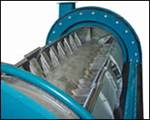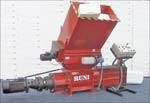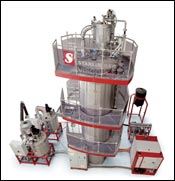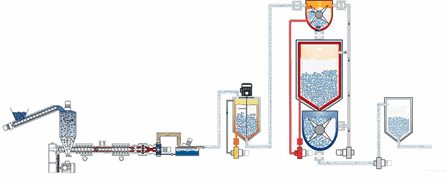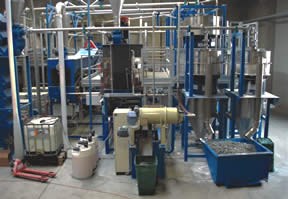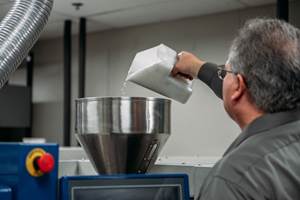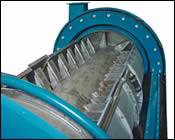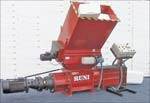Clean and Upgrade Recycled PET
Two recently developed technologies are said to make high-quality PET recycling more economical.
Two recently developed technologies are said to make high-quality PET recycling more economical. One is a continuous system for raising the I.V. while crystallizing and purifying PET reclaim without the need for massive solid-stating reactors. The other is a washing system that requires less capital and energy cost than previous approaches.
Upgrade PET recycle
Last fall, Austrian recycling machinery producer Starlinger & Co. GmbH launched a continuous solid-state polycondensation (SSP) system sized for PET compounders and recyclers. Typical applications are to raise the I.V. of RPET flake for sheet or strapping, decontaminate flake for food-contact applications, and raise the I.V. of textile scrap for use in high-tenacity tire cord. It’s the only continuous, vacuum-based SSP unit available in relatively small sizes (2500 lb/hr). Called Viscostar, it is significantly bigger than Starlinger's older Recostar semi-continuous system for only 500 lb/hr. The Viscostar processes pellets or flake, while smaller Recostar units take only pellets.
Most processors buy APET pellets with the I.V. level they need and dry it for 6 hr at 356 F in a crystallizing dryer before melt processing. The high I.V. required for injection molding preforms or extrusion of film and sheet is typically imparted by the resin producer, using large solid-stating reactors with a nitrogen blanket.
Starlinger’s new Viscostar SSP comes in two versions with the same output of 2500 lb/hr. The SSP 75 holds 7500 liters while the SSP 120 holds 12,000 liters. Larger volume allows proportionately longer residence time and greater I.V. enhancement. The company has sold eight units.
Viscostar SSPs have five parts: a crystallizer, preheater, vacuum unit, reactor vessel, and cooling chamber. The hot-air crystallizer heats pellets or flake to 320 F while stirring to keep the particles from agglomerating. Achieving 15% crystallinity takes about 90 min.
Pellets or flake then go into a preheater, partitioned to heat 330-lb batches from 320 F to the polycondensation reaction temperature of 421 F, which takes about 10 min. Preheated flakes or pellets are then unloaded into the top of the SSP reactor.
There they are held at 421 F under high vacuum to remove acetaldehyde and other volatiles while the I.V. builds at a typical rate of 0.01 to 0.02 dl/g per hour. After the appropriate reaction time, high-I.V. material is dispensed on a first-in/first-out basis from the bottom of the reactor into a partitioned, rotating chamber where it cools under vacuum.
Lower-cost flake washing
One Starlinger customer, PET Recycling Team GmbH in Wollersdorf, Austria, also happens to use a relatively new and economical type of hot-caustic washing system for PET flake. The washing technology comes from STF Maschinen-und-Anlagenbau GmbH in Aicha vorm Wald, Germany. STF is a large plastic recycler that designed its own washing equipment and has sold it to other recyclers for six years (see Strategies, p. 88). The system was first exhibited at K 2004 in Dusseldorf and at Drinktec 2005 in Munich by STF’s sales agent, Plast Engineering Knauff, Taunusstein, Germany. STF’s system is said to be unusually low in initial cost and energy consumption, though exact comparisons are difficult because of the custom nature of each system.
STF’s concept is different from that of the two major commercial PET flake-cleaning systems—from Sorema and Amut in Italy—both of which use a heated prewash stage to remove labels from whole bottles before grinding. STF starts with a wet grinder/crusher to reduce bottles to flake, followed by a succession of small wet-washing units—hot and cold—that use intensive friction. Each washer is followed by a friction dryer to strip off dirty water. STF also uses density separators and metal detectors both before and after washing.
STF uses 2 to 2.5 m³/hr of water for 2000 lb/hr of clean output material, or about 1 m³ of water per 1000 lb of clean flake. STF customers say the resulting flake is almost as clean as that produced by more costly systems.
STF’s wash line starts with bale breaking and conveyors for automatic or manual color sorting. For automatic sortation, STF uses equipment from S+S Separation and Sorting Technology GmbH, Schoenberg, Germany.
Next comes the wet grinder/crusher and then the first density separation, which uses two vessels. One floods the material, the other is a centrifuge that creates a laminar flow to split rising and sinking flake streams. This density separator is similar enough to one from TLT Turbo Laminare Trenntechnik in Germany to be the subject of a patent dispute.
Density separation is followed by two friction dryers, one for the polyolefin “floats” (bottle caps) and one for PET “sinks.” The PET is air-classified to remove fines, labels, and nylon barrier material from beer bottles.
Then come two different hot-water/caustic cleaning steps—a hot screw washer followed by a friction turbo washer. Flake spends about 10 min in each. Residence time can be varied by changing auger speed, depending on contamination level or type of label glue. The latest STF system uses 4% to 5% caustic soda in the screw washer and 2% to 4% caustic in the friction washer.
After each washer, a centrifugal friction cleaner removes dirty water. Then there is a cold post-wash rinsing unit, which is identical to the hot friction turbo washer, but without heat or caustic. Cold washing is also followed by a friction dryer. Then a final density separator uses fresh water to remove any remaining polyolefin flakes. Fresh water used by the cold washer and final density centrifuge is recycled to the hot washers and wet grinder/crusher. Fines, labels, and polyolefins removed by the hot and cold washers and density centrifuges are filtered out and collected in a tub.
The last density centrifuge is followed by two more friction dryers. Recently, PET Recycling Team added a crystallizing predryer in order to sell crystallized flake.
STF guarantees purity levels of 20 ppm or less of metal, 10 ppm or less of paper, and 30 ppm or less of polyolefins. Percentages of colored PET and PVC depend on the detection equipment installed. PET Recycling Team offers flake with less than 10 ppm metal, 50 ppm paper, and 50 ppm polyolefins.
Other Small SSPs Available
There are only a few suppliers of SSP systems for recyclers and compounders. Buhler AG in Switzerland makes small continuous SSP units with throughputs from 1320 to 5500 lb/hr, aimed at bottle-to-bottle applications. They use a nitrogen-blanketed reactor, which Buhler says needs less maintenance than vacuum systems. A Buhler SSP at Amcor in France processes pellets made from undried bottle flake with a Blach 12-screw ring extruder from Extricom GmbH in Germany.
The Vacurema PET recycling system from Erema Engineering in Austria acts like an SSP. It can be continuous or a continuous/batch hybrid suitable for bottle-to-bottle applications. Throughputs are 440 to 4400 lb/hr.
Erema also has a new Multi KT SSP reactor, which processes in batches but feeds continuously to the extruder. After testing for six months, the first commercial system is being built.
Other machine builders offer batch-type vacuum SSP units that can be used for recycled PET flake. One example is OHL in Germany, recently acquired by Schoeller Wavin Systems NV in Hardenberg, the Netherlands.
Related Content
Nova Chemicals Attains FDA Letter for Mechanically Recycled LLDPE
RLLDPE product will be marketed for applications including food packaging.
Read MorePurecycle to Receive Expanded FDA Letter of No Objection for PureFive Resin
LNO expands the conditions of use for which the recycled polypropylene can be used.
Read MoreExtrusion Technology Extended to Injection, Enabling Up to 100% Regrind Usage
Twin-barrel (shot-pot) press can handle more regrind, offers other benefits to molders.
Read MoreMarket Changes Spur Industrial Recycler to Enhance Capabilities in Clear Plastic Reprocessing
Butler MacDonald found new business and flexibility thanks to a big step-up in purging efficiency.
Read MoreRead Next
NPE 2006 News Wrap-Up: Recycling and Scrap Reclaim
NPE was full of new equipment and systems for recapturing valuable in-plant scrap and post-consumer/post-industrial plastic waste. Recovery of PET packaging and film or fiber waste were particular areas of emphasis, as were lots of new granulators, from the world’s biggest to micro-size and even ‘clean-room’ models.
Read MoreK 2004 Wrap-Up on Recycling & Scrap Reclaim: Turn Trash to Cash with New Compactors, Shredders and Grinders
Topping recycling news at the latest giant K Show in Dusseldorf, Germany, were new compactor technologies for films and foams that can densify plastic waste for recycling and even mold finished parts—not just save space in a landfill.
Read MoreFor PLASTICS' CEO Seaholm, NPE to Shine Light on Sustainability Successes
With advocacy, communication and sustainability as three main pillars, Seaholm leads a trade association to NPE that ‘is more active today than we have ever been.’
Read More
